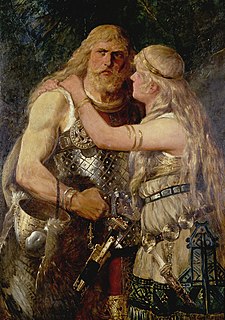
Marriage, also called matrimony or wedlock is a culturally recognized union between people called spouses. It establishes rights and obligations between them, as well as between them and their children, and between them and their in-laws. It is considered a cultural universal, but the definition of marriage varies between cultures and religions, and over time. Typically, it is an institution in which interpersonal relationships, usually sexual, are acknowledged or sanctioned. In some cultures, marriage is recommended or considered to be compulsory before pursuing any sexual activity. A marriage ceremony is called a wedding.

A wedding is a ceremony where two people are united in marriage. Wedding traditions and customs vary greatly between cultures, ethnic groups, religions, countries, and social classes. Most wedding ceremonies involve an exchange of marriage vows by a couple, presentation of a gift, and a public proclamation of marriage by an authority figure or celebrant. Special wedding garments are often worn, and the ceremony is sometimes followed by a wedding reception. Music, poetry, prayers, or readings from religious texts or literature are also commonly incorporated into the ceremony, as well as superstitious customs.
Levirate marriage is a type of marriage in which the brother of a deceased man is obliged to marry his brother's widow. Levirate marriage has been practiced by societies with a strong clan structure in which exogamous marriage is forbidden. It has been known in many societies around the world.
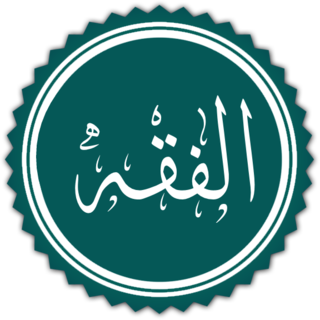
In Islam, a mahr is the obligation, in the form of money or possessions paid by the groom, to the bride at the time of Islamic marriage. While the mahr is often money, it can also be anything agreed upon by the bride such as jewelry, home goods, furniture, a dwelling or some land. Mahr is typically specified in the marriage contract signed upon marriage.

The Somalis are an East Cushitic ethnic group native to the Horn of Africa who share a common ancestry, culture and history. The Somali language is the shared mother tongue of ethnic Somalis, which is part of the Cushitic branch of the Afroasiatic language family, and are predominately Sunni Muslim. They form one of the largest ethnic groups on the African continent, and cover one of the most expansive landmasses by a single ethnic group in Africa.

Dower is a provision accorded by law but traditionally by a husband or his family, to a wife for her support in the event that she should become widowed. It was settled on the bride by agreement at the time of the wedding, or as provided by law.
Arranged marriage is a tradition in the societies of the Indian subcontinent, and continue to account for an overwhelming majority of marriages in the Indian subcontinent. Despite the fact that romantic love is "wholly celebrated" in both Indian mass media and folklore, and the arranged marriage tradition lacks any official legal recognition or support, the institution has proved to be "surprisingly robust" in adapting to changed social circumstances and has defied predictions of decline as India modernized.

The Demographics of Somalia encompass the demographic features of Somalia's inhabitants, including ethnicity, language, population density, education level, health, economic status, religious affiliations and other aspects of the population. Somalia is believed to be one of the most homogeneous countries in sub-Saharan Africa.

The Transitional Federal Government (TFG) was internationally recognized as a provisional government of the Republic of Somalia from April 2004 until 20 August 2012, when its tenure officially ended and the Federal Government of Somalia was inaugurated.
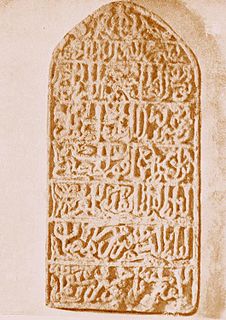
Wadaad writing, also known as Wadaad Arabic, is the traditional Somali adaptation of written Arabic, as well as the Arabic script as historically used to transcribe the Somali language. Originally, it referred to an ungrammatical Arabic featuring some words in Somali, with the proportion of Somali vocabulary terms varying depending on the context. Alongside standard Arabic, wadaad writing was used by Somali religious men (wadaado) to record xeer petitions and to write qasidas. It was also used by merchants for business and letter writing. Over the years, various Somali scholars improved and altered the use of the Arabic script for conveying Somali. This culminated in the 1950s with the Galal alphabet, which substantially modified letter values and introduced new letters for vowels.
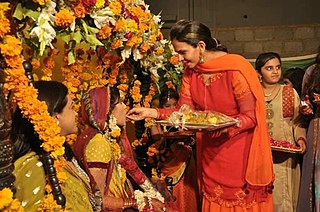
Marriage in Pakistan pertains to wedding traditions established and adhered by Pakistani men and women. Despite their local and regional variations, marriages in Pakistan generally follow Islamic marital jurisprudence. Culturally, marriages are not only seen as a union between a husband and a wife, but also an alliance between their respective families. These traditions extend to other countries around in the world where Overseas Pakistani communities exist.
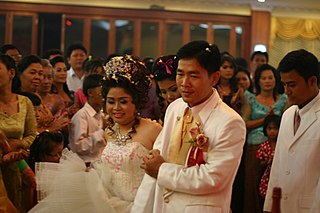
Courtship, marriage, and divorce in Cambodia are important aspects of family life. Customs vary as between rural and urban areas, with many city dwellers being influenced by western ideas. The choice of a spouse is usually undertaken by the families of young men and women, sometimes with the help of a matchmaker. A man usually marries between the ages of nineteen and twenty-five and a girl between sixteen and twenty-two.
Xeer is the traditional legal system of Somalia, Somaliland, Djibouti, Somali Region, and one of the three systems from which formal Somali law draws its inspiration, the others being civil law and Islamic law. It is believed to pre-date Islam, although it was influenced by Islam and retains the faith elements, the proceeding under rule pre-date Islam. Under this system, elders, known as the xeer begti serve as mediator judges and help settle court cases, taking precedent and custom into account. Xeer is polycentric in that different groups within Somali society have different interpretations of xeer.

Hizbul Islam, also known as Hizbul Islaami, Hisbi Islam, or Hezb-ul Islam, was a Somali Islamist group formed after four Islamist groups merged to oppose the new Somali government of President Sheikh Sharif Ahmed. The four groups were: Hassan Aweys' the ARS-A, Jabhatul Islamiya, Hassan Abdullah Hersi al-Turki's the Mu'askar Ras Kamboni and Muaskar Anole, the [[Marehan (Darod)|Marehan clan's Militia and Harti clan's militia. These groups previously took part in the fighting against the Ethiopian occupation of Somalia.

Traditional marriage customs in the Philippines and Filipino wedding practices pertain to the characteristics of marriage and wedding traditions established and adhered by them Filipino men and women in the Philippines after a period of adoption courtship and engagement. These traditions extend to other countries around the world where Filipino communities exist. Kasalan is the Filipino word for "wedding", while its root word – kasal – means "marriage". The present-day character of marriages and weddings in the Philippines were primarily influenced by the permutation of Christian, both Catholic and Protestant, Hindu, Islam, Chinese, Spanish, and American models.

Muslim marriage and Islamic wedding customs are traditions and practices that relate to wedding ceremonies and marriage rituals prevailing within the Muslim world. Although Islamic marriage customs and relations vary depending on country of origin and government regulations, both Muslim men and women from around the world are guided by Islamic laws and practices specified in the Quran.
Arranged marriage is a type of marital union where the bride and groom are primarily selected by individuals other than the couple themselves, particularly by family members such as the parents. In some cultures a professional matchmaker may be used to find a spouse for a young person.
The predominant religion in Somalia is Islam.

This is a list of Somali aristocratic and court titles that were historically used by the Somali people's various sultanates, kingdoms and empires. Also included are the honorifics reserved for Islamic notables as well as traditional leaders and officials within Somali customary law (xeer), in addition to the nobiliary particles set aside for distinguished individuals.

Freedom of religion in Somalia refers to the extent to which people in Somalia are freely able to practice their religious beliefs, taking into account government policies, non-state actors, and societal attitudes toward religious groups. Due to the Somali Civil War, the enforcement of laws pertaining to religion by the various autonomous governments in the region is inconsistent.














